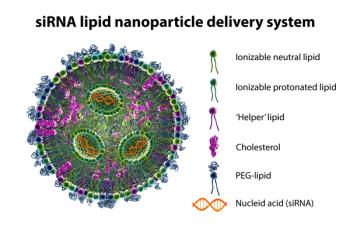
- The Column-05-24-2016
- Volume 12
- Issue 9
Trends and Challenges for Bioanalysis and Characterization of Small and Large Molecule Drugs
Structural, bioanalytical, characterization, and quality control studies are critical for successful drug development. These studies must be as accurate, sensitive, and selective as possible, and liquid chromatography coupled to tandem mass spectrometry (LC–MS–MS) has been the technique of choice for many areas of small molecule analysis for the past 30 years. During that time, rapid improvements in analytical technologies have supported the development of more sensitive and robust methods. However, the pharma and biopharma industry continues to need more powerful instruments and more diverse methods, particularly as therapeutics have expanded to include large molecules. This work follows on from an earlier article that explored the limitations of LC–MS–MS for bioanalysis of biologics. This article considers some of the current issues for analysis of small and large molecules, and emerging trends in method development.
Structural, bioanalytical, characterization, and quality control studies are critical for successful drug development. These studies must be as accurate, sensitive, and selective as possible, and liquid chromatography coupled to tandem mass spectrometry (LC–MS–MS) has been the technique of choice for many areas of small molecule analysis for the past 30 years. During that time, rapid improvements in analytical technologies have supported the development of more sensitive and robust methods. However, the pharma and biopharma industry continues to need more powerful instruments and more diverse methods, particularly as therapeutics have expanded to include large molecules. This work follows on from an earlier article that explored the limitations of LC–MS–MS for bioanalysis of biologics.1 This article considers some of the current issues for analysis of small and large molecules, and emerging trends in method development.
Liquid chromatography coupled to mass spectrometry (LC–MS)-based techniques have been widely used in drug discovery and development laboratories since the 1990s because of their powerful abilities to identify and quantify low levels of compounds very quickly, within samples containing hundreds or thousands of other substances.2 LC coupled to tandem MS (LC–MS–MS) has become particularly important for structural elucidation, ADME, and bioanalysis studies of small molecule drugs. These challenging applications require extremely accurate and reproducible compound detection at ever-decreasing concentrations. In recent years, there has been rapid growth in the development of biotherapeutics, and analysis of these larger molecule drugs introduces a number of challenges that are also driving new developments in technology and methods.
Bioanalysis and Small Molecule Drugs
For decades, drug developers have depended on bioanalysis studies to provide accurate measurements of drug concentrations in a given sample, at the time of sample collection.3 The accuracy of these studies depends on the method and on the reliability of the laboratory’s analytical instruments, which must be able to quantify the compound of interest with adequate selectivity and specificity. This has always been particularly challenging as a result of the typically high presence of structurally related and non-related compounds in bioanalysis samples, such as plasma, blood, and other complicated matrices. These can cause cross-reactivity with affinity reagents or co-elution of unrelated compounds, impacting the accuracy and reproducibility of the assay.4
Over the years, LC–MS–MS-based methods have been developed to overcome these challenges, offering increasing sensitivity, throughput, accuracy, and reproducibility for drug quantification. A common approach has been to use multiple reaction monitoring (MRM) on triple quadrupole mass spectrometers to reduce noise while improving selectivity and accuracy of quantification. More recently this has been extended to MRM3, which increases the number of fragmentation steps for further improvements in selectivity.5 Today’s triple quadrupole MS systems with MRM have been used to develop validated methods for detecting small molecule drugs at low pg/mL concentrations, with good reproducibility, linearity, and signal-to-noise ratios.6
Some compounds are particularly difficult to separate out in biological samples because of matrix interference, which can cause unresolved peaks or high baselines, impacting the data reproducibility, accuracy, and dynamic range.5 These effects have traditionally been overcome through incorporating additional sample clean-up steps or through using slower chromatography. However, these add significant time, cost, and labour that most drug development laboratories cannot afford, as they come under pressure to increase their sample throughput. Alternative technologies have become available over the past few years that combine ion mobility separation with LC–MS to offer increased selectivity. These are either in the form of ion mobility devices that can be attached to the front-end of time-of-flight (TOF) and triple quadrupole MS systems, or built in to a TOF-MS system, but the majority of these are unable to meet the balance of speed, selectivity, and robustness required for bioanalysis.7 More recently, differential ion mobility separation devices have been developed for orthogonal separation of ions in between the LC and MS stages of the analysis. The ions are separated in trajectory, based on the difference in their mobility, as opposed to separated in time. This removes background components, providing a system that can be used with short MRM cycle times for rapid and accurate detection of compounds at low levels in complex matrices.5
Bioanalysis laboratories are increasingly adopting microflow LC-based methods for analyzing compounds at very low levels of detection. This technique uses smaller diameter columns (under 1 mm) and electrodes, resulting in faster separations with improved sensitivity and resolution, with minimal post-column dispersion. The lower flow rate also increases the ionization efficiency to reduce ion suppression, while using significantly lower amounts of sample and solvent, offering economic and environmental advantages to pharmaceutical development. The lower sample volumes needed for microflow LC are well suited for the industry’s growing interest in using microsampling techniques for toxicology and bioanalysis studies.8,9 Moreover, microflow LC can be combined with differential ion mobility MS for extremely sensitive and selective analysis of compounds in biological samples.10,11
Bioanalysis and Large Molecule Drugs
The accuracy, robustness, and reproducibility of bioanalysis studies remain key concerns for drug developers and regulatory authorities. However, traditionally used LC–MS–MS methods for small molecule bioanalysis are usually inappropriate for studying large molecule drugs such as antibodies, growth factors, oliognucleotides, and recombinant peptides. The greater size and complexity of these molecules mean they typically require extensive sample preparation prior to analysis; their adsorptive properties and interference from background proteins can further affect quantification accuracy.
LC–MS–MS methods have been optimized for the direct analysis of small peptides (under 10 kDa); these typically require immunaffinity-mediated sample extraction and/or sample enrichment steps in order to enhance selectivity, prior to quantifying the intact analyte. For larger proteins, more extensive workflows are usually required that include proteolytic digestion of the protein prior to LC–MS–MS analysis of a surrogate peptide.4,12,1 This indirect analytical method is widely accepted but can be highly laborious, and is associated with complications such as variable peptide release.1 Furthermore, guidance for validation of these methods has yet to be issued by the regulatory authorities.4
Ligand binding assays (LBA) such as ELISAs provide a well-established technique for quantifying proteins, and for bioanalysis they have the advantage of being able to detect circulating “free” drugs as well as physiologically active forms. However, LBAs have a number of limitations that preclude their use in high throughput drug development.13,12 In a recent development, researchers have begun combining LBAs with LC–MS–MS.14,15 This approach brings together the selectivity and sensitivity advantages of LC–MS–MS with the specificity and broader immunocapture capabilities offered by LBAs.
These method developments have been supported by several technology improvements for triple quadrupole and QTRAP MS systems, including improvements in sensitivity that allow detection of large molecules at low nanogram to picogram levels.16 These new technologies offer improved ionization and sampling efficiencies, increased dynamic range, and switchable (dual) mass ranges that allow ions of different mass to pass through the detector. As a result, validated methods are now available for quantifying a variety of challenging drugs such as the cytokine-inhibitor, adalimumab;17 the glucose-raising hormone, glucagon;18 the insulin analogue, glargine;19 and antibody-based treatments such as infliximab, for autoimmune diseases, and trastuzumab for breast cancer.
Characterization of Large Molecules
Most large molecule drugs are prone to inconsistencies in the form of naturally occurring sequence modifications and biotransformations, as a result of their production processes. These changes can affect the efficacy of the drug, as well as its bioavailability and safety. As a result, pharmaceutical analysis laboratories regularly perform protein characterization studies to monitor sequence degradation and post-translational modifications, such as amino acid changes and glycosylations. These studies have previously been performed using LBAs or capillary electrophoresis (CE) technologies.21 CE is powerful and robust but typically labour intensive for full characterizations, particularly when dealing with complex therapeutics such as antibody-drug conjugates that may require repeated runs for different analytics and incur complicated data processing.
In recent years, technology developments have led to several improved methods for protein characterization. These include combining differential ion mobility separation with LC–MS for improved and simplified analyses.20 Elsewhere, the integration of CE technologies with electrospray ionization (CESI) has led to the development of CESI–MS techniques, which promise rapid and greatly simplified protein analysis. The development combines the high separation efficiency of CE with nanoflow LC, which maximizes the ionization efficiency and minimizes ion suppression.21 CESI–MS systems are designed with open-tube capillaries, thereby eliminating the occurrence of dead volumes, and resulting in improved sensitivity and peak efficiency. There is also no stationary phase, which is important for ensuring peptides are not lost or excessively retained. In a recent example, the breast cancer drug, trastuzumab, was fully characterized from a single protease digestion and a single run using CESI–MS. The method obtained 100% sequence coverage and identified several key amino acid modifications; comprehensive glycopeptide analysis was also performed from the same separation.21
Biotransformations such as deamidations, oxidations, and structural changes can be challenging to detect with conventional methods, such as LBAs. Trastuzumab is known to undergo in vivo deamidation at a crucial position in its structure, and antibodies used in validated ELISAs are unable to recognize the deamidation. Scientists recently developed an LC–MS–MS-based method for quantitative monitoring of this biotransformation, using tryptic digestion followed by quantification of a signature peptide with selected reaction monitoring. The method was shown to successfully quantify the deamidation-sensitive signature peptide and its deamidated products simultaneously.22
Conclusions
Successful drug development and drug safety depend on numerous analytical testing processes at several steps during the development pipeline, and during ongoing characterization of commercial large-molecule drugs. It is essential that the industry and patients can rely on the accuracy and reproducibility of this analytical testing. Over the years we have seen continual improvements in the capabilities of analytical technologies, driven by the highly competitive and strictly regulated nature of the pharmaceuticals industry. During recent years in particular there have been a number of innovative developments in instrumentation engineering, as well as in method development, that are allowing scientists to explore novel therapeutic molecules and increasingly complex compounds. In the future these developments are likely to require even more diverse analytical methods, with continual improvements in speed, selectivity, and accuracy.
References
- S. Ramagiri, The Column11(22), 31–36 (2015).
- T. Covey, The Column9(16), 11–16 (2013).
- E.D. Bashaw, B. DeSilva, M.J. Rose, Y.M.C. Wang, and C. Shukla, The AAPS Journal16(3), 586–591 (2014).
- J.X. Duggan, F. Vazvaei, and R. Jenkins, Bioanalysis7(11), 1389–1395 (2015).
- Y. LeBlanc, D. Caraiman, M. Aiello, and H. Ghobarah, Sciex technical note, publication no. 2960211-01 (2011).
- R. Baghla, B. Jagadeesh, L. Ramalinga, S. Prasad, A. Kumari, M. Pillai, S. Rumagiri, and D. Bhattacharyya, Sciex technical note, publication no. 10800514-01 (2014).
- S. Taylor, The Column10(15), 14–17 (2014).
- L.B. Nilsson, M. Ahnoff, and O. Jonsson, Bioanalysis5(6), 731–738 (2013).
- K. Chapman, S. Chivers, D. Gliddon, et al., Drug Discovery Today19(5), 528–532 (2014).
- M. Qi, M. Morena, H.A. Vecchiarelli, M.N. Hill, and D.C. Schriemer, Rapid Communications in Mass Spectrometry29(20), 1889–1897 (2015).
- D.M. Warren and S. Maitra, Sciex application note, publication no. RUO-MKT-02-2049 (2015).
- R. Jenkins, J.X. Duggan, A.F. Aubrey, et al., The AAPS Journal 17(1), 1–16 (2015).
- K. Peng, K. Xu, L. Liu, et al., mAbs6(6), 1500–1508 (2014).
- W.D. Van Dongen and W.M. Niessen, Bioanalysis4(19), 2391–9 (2012).
- I. Moore, C. Yang, G. Impey, W. Woroniecki, L. Xiong, H.-F. Liu, L. Baker, and S. Ramagiri, Sciex application note, publication no. RUO-MKT-02-2258 (2015).
- A. Romanelli, L. Olson, T. Biesenthal, and H. Ghobarah, Sciex technical note, publication number: 5780212-01 (2012).
- Sciex iMethods for Pharma and BioPharma, A universal immunocapture-LC-MS/MS workflow for biological compound quantitation in preclinical studies – adalimumab. Publication no. RUO-MKT-02-2250-A (2015).
- Sciex iMethods for Pharma and BioPharma, Highly sensitive and accurate quantification of glucagon peptide hormone in human plasma. Publication no. 8540113-01 (2015).
- Sciex iMethods for Pharma and BioPharma, A sensitive and robust immunocapture-LC-MS/MS workflow for quantitation of insulin glargine in human plasma. Publication no. RUO-MKT-02-2241 (2015).
- T. Gamble, J.C.Y. LeBlanc, E. Johansen, and S. Ramagiri, Biologics Analytical Characterization Compendium, pp 12–15 (Sciex technical series) (2016).
- M. Lies, C. Lew, J.-L. Gallegos-Perez, B. Fonslow, R. Lakshmanan, and A. Guttman, Biologics Analytical Characterization Compendium, pp 56–65 (Sciex technical series) (2016).
- P. Bults, R. Bischoff, H. Bakker, J.A. Gietema, and N.C. van de Merbel, Analytical Chemistry88(3),1871–1877 (2016).
Suma Ramagiri, PhD, is a senior manager, Global Pharma/Biopharma Markets at Sciex.
Articles in this issue
over 9 years ago
LGC Awarded Ethical Statusover 9 years ago
Novel Fatty Acid Analysisover 9 years ago
Investigating Meat Authenticityover 9 years ago
Past, Present, Futureover 9 years ago
Vol 12 No 9 The Column May 24, 2016 Europe and Asia PDFover 9 years ago
Vol 12 No 9 The Column May 24, 2016 North American PDFover 9 years ago
The Importance of Specifications for Method TransferNewsletter
Join the global community of analytical scientists who trust LCGC for insights on the latest techniques, trends, and expert solutions in chromatography.





